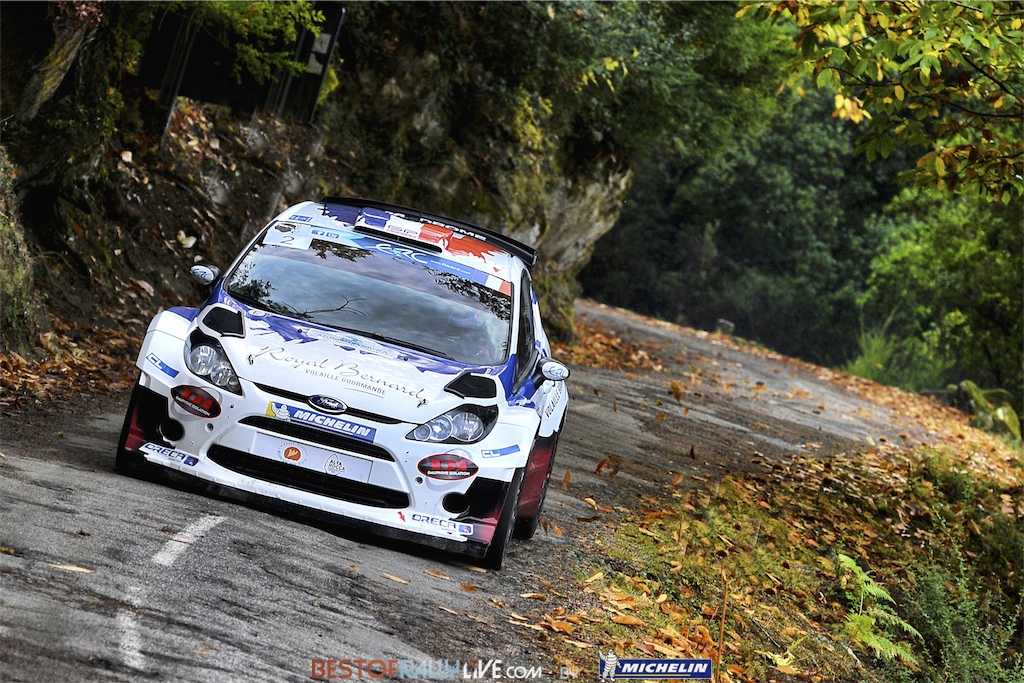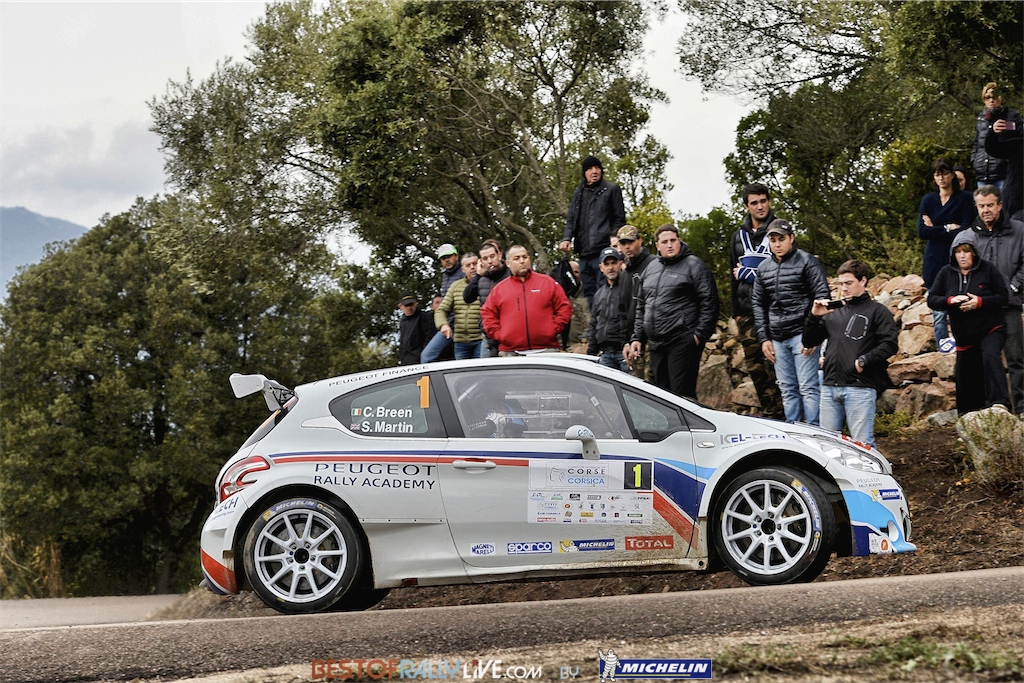Deux Français, deux anciens champions de France, au volant de deux Ford Fiesta RRC/Michelin se disputent la première place du Tour de Corse, dernière manche du Championnat d’Europe des Rallyes FIA. A l’issue de la première journée, Stéphane Sarrazin est leader avec 1.7 seconde d’avance sur Bryan Bouffier. Le néo-champion d’Europe, Esapekka Lappi (Skoda), est sorti de la route.
La première étape du 57e Giru di Corsica, organisée autour de Porto-Vecchio, a été dominée par les pilotes français. De retour de Chine et d’une 2e place aux 6 Heures de Shanghai, Stéphane Sarrazin a vite retrouvé ses marques sur les petites routes insulaires rendues piégeuses par l’humidité.
Sarrazin a remporté l’ES1 avec moins d’une seconde d’avance sur Bryan Bouffier. Dans l’ES2, les deux Français ont fait jeu égal…Mais l’issue de la 1ère boucle, c’est Bryan Bouffier qui est rentré en leader à Porto-Vecchio, avec une avance de 2.4 secondes, avant de connaître une crevaison dans la spéciale suivante. « A 6 km de l’arrivée, j’ai peut-être trop coupé une corde ». La robustesse de son pneu Michelin R31 lui a permis de terminer la spéciale à seulement 17 secondes de son adversaire, qui, de son côté, avait opté pour des gommes medium cet après-midi. Peut-être pas le meilleur choix, si bien que Bouffier est revenu à 1.7 seconde au classement général.
Derrière, le Néerlandais Kevin Abbring (Peugeot) se retrouve isolé à la 3e place après la sortie de route d’Esapekka Lappi (Skoda) dans la dernière spéciale du jour. Le Finlandais était assuré du titre européen 2014 avant le départ du Tour de Corse suite au forfait de son seul challenger Sepp Wiegand.
Au volant de sa Peugeot 207 S2000, Eric Camilli pointe à la 4e place. Le lauréat Rallyes Jeunes 2012 devance de plus d’une minute le Champion de France sortant Julien Maurin (5e, Ford), victime de deux crevaisons, et le pilote officiel Porsche Romain Dumas (6e), qui revient lui aussi de Chine où il a également terminé sur le podium des 6 Heures de Shanghai. Hormis dans l’ES1/4, la Porsche 997 GT3 RS n’était pas au mieux sur les routes sinueuses et glissantes de cette journée.
Bruno Magalhaes (7e, Peugeot), Jaromir Tarabus (8e, Skoda), Jean-Mathieu Léandri (9e, Peugeot) et Keith Cronin (10e et 1er Production, Subaru) complètent le top-ten provisoire. En catégorie Junior, le titre européen se joue ce week-end entre Stéphane Lefebvre et Andrea Crugnola. Au terme de la 1ère étape, l’Italien devance le Français d’1min06s5…
Demain, la seconde étape emmènera les concurrents autour d’Ajaccio avec cinq longues spéciales à disputer avant l’arrivée du Tour de Corse, et la conclusion de la saison européenne 2014, en fin d’après-midi.

The overnight leaderboard in Corsica is topped by two ex-French champions driving Michelin-equipped Ford Fiesta RRCs. Stéphane Sarrazin is provisionally 1.7 seconds clear of Bryan Bouffier. The newly-crowned European champion Esapekka Lappi (Skoda) has crashed.

The first day of the 2014 Tour de Corse in the Porto-Vecchio region was dominated by French drivers.
Freshly back from his World Endurance Championship race in China, Sarrazin lost no time finding his marks despite the treacherous, damp conditions.
He was faster than Bouffier on SS1 before the two were equal fastest on the following test. The morning’s loop saw the latter emerge ahead, however, 2.4s in front of his compatriot.
Bouffier then picked up a puncture on the following stage. “I cut a corner too much about 6km from the end,” he reported. Even so, the strength of his Michelin R31 tyre enabled him to limit the damage to just 17s compared with Sarrazin who chose medium tyres for the afternoon’s loop. It probably wasn’t the ideal option, since Bouffier succeeded in closing the gap to 1.7s this evening.
Dutchman Kevin Abbring (Peugeot) follows in third spot after Lappi put his Skoda off the road on today’s last stage. The Finn is sure of the European title, however, due to the last-minute withdrawal from the event of Sepp Wiegand.
Eric Camilli (Peugeot 207 S2000) is fourth, more than a minute safe from last year’s French champion Julien Maurin (Ford), who suffered two punctures, and ahead of Porsche driver Romain Dumas (6th) who, like Sarrazin, finished on the podium of last Sunday’s 6 Hours of Shanghai. With the exception of SS1/4, his Porsche 997 GT3 RS wasn’t totally at ease on today’s twisty, slippery stages.
The top 10 is rounded off by Bruno Magalhaes (Peugeot), Jaromir Tarabus (Skoda), Jean-Mathieu Léandri (Peugeot) and Keith Cronin (Subaru, Production class leader).
The ERC Junior title will be settled this weekend. Andrea Crugnola is currently 1m6.5s clear of the championship’s leader Stéphane Lefebvre.
The second (and last) day will see the event’s epicentre shift closer to Ajaccio. After five more stages, the 2014 Tour de Corse will bring the FIA European Championship to a close at the end of Saturday afternoon.



